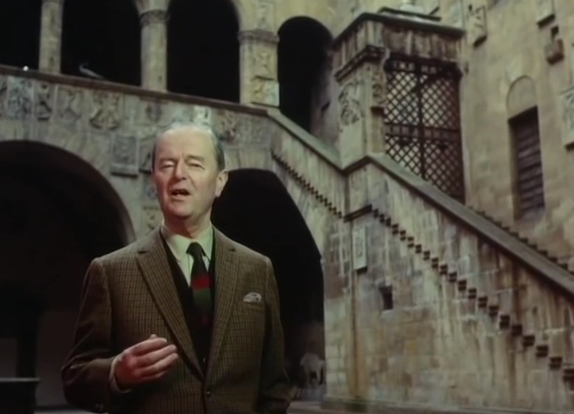
This week Clark takes us from Florence to 16th century Papal Rome, noting the convergence there of Christianity and antiquity. He highlights the brilliance of the High Renaissance and its masters – Michelangelo, Raphael, and Leonardo da Vinci – and their works in the courtyards of the Vatican, the rooms decorated for the Pope by Raphael, and the Sistine Chapel.
The Hero as Artist
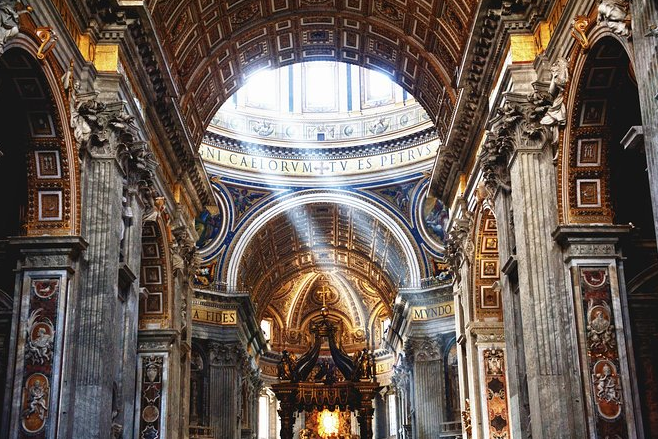
Rome as Compost Heap: Our move from Florence to Rome takes us “from the city of hard heads, sharp wits, light feet, graceful movement, to a city of weight, a city that was like a huge compost heap of human hopes and ambitions, a wilderness of imperial splendour.” Many of the great edifices of Roman antiquity still survived but the contemporary Roman masses lived amongst them like dwarves in a land of giants. They felt “crushed by their gigantic scale,” and declared such monumental buildings to be “the works of demons,” even as they “built their huts in them” and used them as quarries and stables for their herds of cows and goats.
An Alter Ego: But then, around 1500AD, “a great change overcame the civilisation of the Renaissance.” Its “lively and intelligent” champions “began to realise that the monoliths around them had been built by human beings,” titans that they wanted to emulate. This transformation in consciousness had been driven not only by early efforts in a new science that would become archaeology, but by Humanist scholars. Their relentless efforts had revealed an ancient world that seemed to speak directly to the artists, poets, architects, and politicians of the Renaissance. It was as if their present world possessed an heroic alter ego that had lived in the past and had now been unearthed after a millennium in obscurity. Unlike the oppressed peasants amongst the ruins, the masters of this new world were
in no mood to be crushed by antiquity … they meant to absorb it, to equal it, to master it. They were going to produce their own race of giants and heroes.
Edifice Complex: Leadership in this re-birth was provided by the notorious ‘Renaissance Popes’ (see appendix). These, Clark asserts, “were men of unusual ability who used their international contacts, their great civil service, and their increasing wealth in the interests of civilisation.” Accordingly, “it was Nicholas V, the friend of Alberti and the Humanists who first saw that papal Rome could revive the grandeurs of pagan Rome.” This confidence was given concrete expression when Julius II conceived “a project so audacious, so extravagant” as to be almost beyond belief: “he decided to pull down old St Peter’s, one of the largest and most ancient churches in the western world, and certainly the most venerable.” In its place he wanted a vast new church based on the perfect forms the Humanists had uncovered and it had to surpass anything seen before, even in the greatest years of antiquity. In this colossal cathedral a new philosophy found expression – “a visible alliance between Christianity and antiquity was achieved.”

Michelangelo: We turn now to one of the great heroes in the history of civilisation. As Ernst Gombrich says in The Story of Art:
It is very difficult for any ordinary mortal to imagine how it could be possible for one human being to achieve what Michelangelo achieved … He gave humanity a new idea of the power of genius.
 From David to David: Commissioned by the Florentine Republic to celebrate heroic-patriotic themes, Michelangelo set to work on a gigantic piece of marble that had defeated all previous attempts to make something of it. He produced David, depicting the young hero about to venture forth to confront Goliath and his own destiny (above).
From David to David: Commissioned by the Florentine Republic to celebrate heroic-patriotic themes, Michelangelo set to work on a gigantic piece of marble that had defeated all previous attempts to make something of it. He produced David, depicting the young hero about to venture forth to confront Goliath and his own destiny (above).
Clark compares it with Verrocchio’s earlier depiction (right) of a petite, almost girl-like David, wearing a brief little tunic, standing over the severed head of Goliath. In these contrasting visions, Clark declares that “one sees there has been a turning point in the human spirit.” This is exemplified not only in the taut, muscular body, but above all in the head, where “we become aware of a spiritual force that the ancient world never knew.”
The Epitome of Civilisation: Clark unleashes the full aesthetic sensibility of civilisation on this topic. He concedes that this spiritual quality that he detects in Michelangelo’s David,
which I may call heroic, is not part of most people’s idea of civilisation. It involves contempt for convenience and a sacrifice of all those pleasures that contribute to what we call civilized life. It is the enemy of happiness.
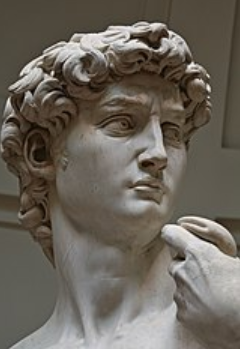 Heroic Resolve: So what heroic quality does Clark see in David’s intense gaze (left)? It seems he sees there an unyielding heroic resolve, as the young champion prepares to face his gigantic enemy. It is a gaze that invites us
Heroic Resolve: So what heroic quality does Clark see in David’s intense gaze (left)? It seems he sees there an unyielding heroic resolve, as the young champion prepares to face his gigantic enemy. It is a gaze that invites us
to recognize that to despise material obstacles, and to defy even the blind forces of fate, is man’s supreme achievement; and since, in the end, civilisation depends on man extending his powers of mind and spirit to the utmost, we must reckon the emergence of Michelangelo as one of the great events in the history of Western civilisation.
The Elevation of the Body: From his youth Michelangelo had been entranced by the human body and had studied it more exhaustively than any other artist in history. Now, in his paintings and sculptures, he gave expression to a new vision of corporeality. After the Gothic era, in which “the body had been the subject of shame and concealment,” he offered a radical new vision,
the first authoritative statement that the human body … could be made the means of expressing noble sentiments, life-giving energy and God-like perfection.
As Clark emphasizes
This was an idea that was to have an incalculable influence on the human mind for 400 years – an influence that lasted until Picasso’s Demoiselles d’Avignon.
At that point, 111 years ago, this heroic vision of the body began to fall apart, as subsequent modern art has demonstrated.

The Pietà: This heroic vision contrasts starkly with the incredible emotions of grief and sadness evoked by Michelangelo in the Pietà, produced when he was only about 25 and probably the greatest sculpture ever created (above). The profundity of its message at the human level is heightened by the theological implications of an image of the mother of God holding her dead son in her arms.
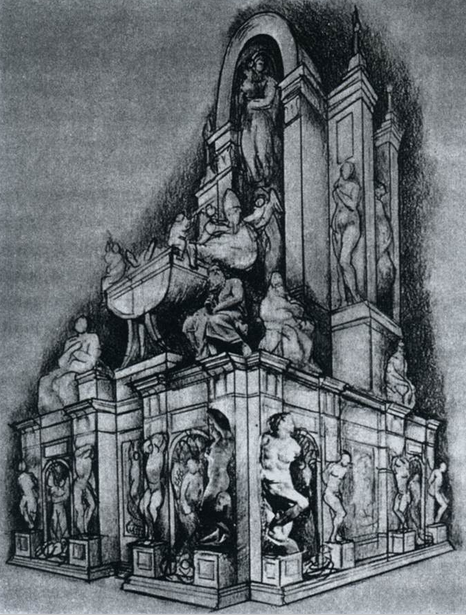
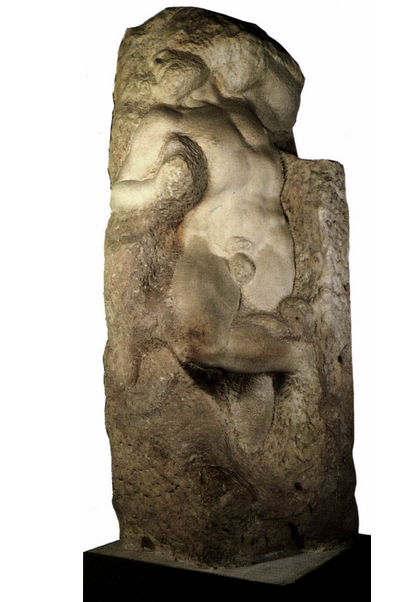 Freeing the Soul from Matter: Clark turns to the utterly grandiose, but never-built (right) tomb of Pope Julius II, which Michelangelo was commissioned to build and decorate with massive heroic sculptures. Some of these survive and, like Michelangelo’s other work, “they add something new to the European spirit.”
Freeing the Soul from Matter: Clark turns to the utterly grandiose, but never-built (right) tomb of Pope Julius II, which Michelangelo was commissioned to build and decorate with massive heroic sculptures. Some of these survive and, like Michelangelo’s other work, “they add something new to the European spirit.”
However, some are unfinished (left) and remain forever imprisoned in marble, and it is these that best
express Michelangelo’s deepest preoccupation: the struggle of the soul to free itself from matter.
The ‘Beethoven Element’: Note that through this discussion Clark makes reference to what he calls “the Beethoven element,” likening the advent of Michelangelo to “the progression that we shall find in music between Mozart and Beethoven,” i.e., from the Classical to the Romantic Era in music, an idea to which he returns later in the series.
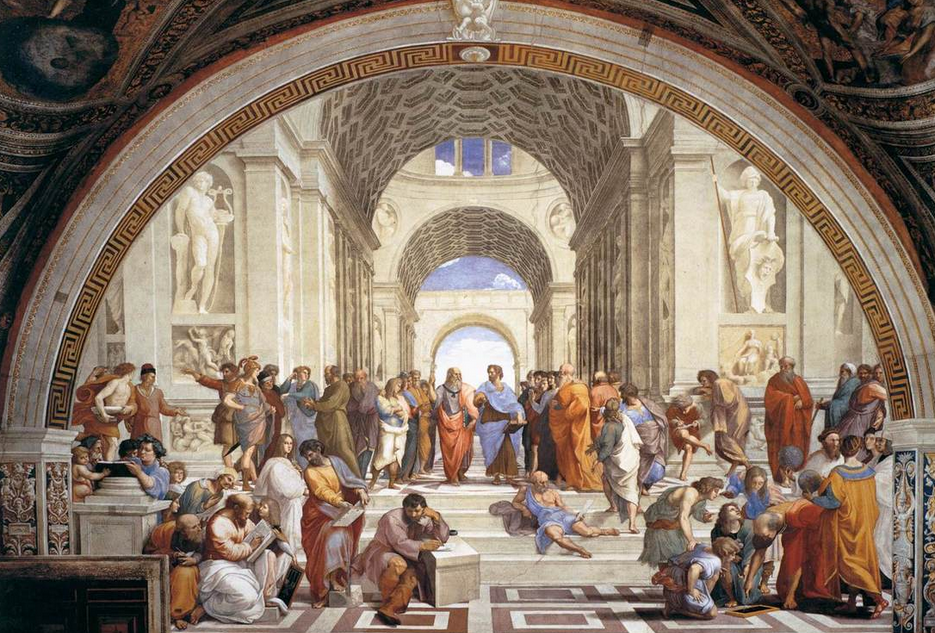
Show, Don’t Tell: Clark observes that
people sometimes wonder why the Renaissance Italians, with all their intelligent curiosity, didn’t make more of a contribution to the history of thought. The reason is that the most profound thought of the time was not expressed in words, but in visual imagery.
He then offers two examples of this: Michelangelo’s Sistine Chapel ceiling; and Raphael’s frescoes in the Stanza della Segnatura (above), the Pope’s personal library in the papal apartments.
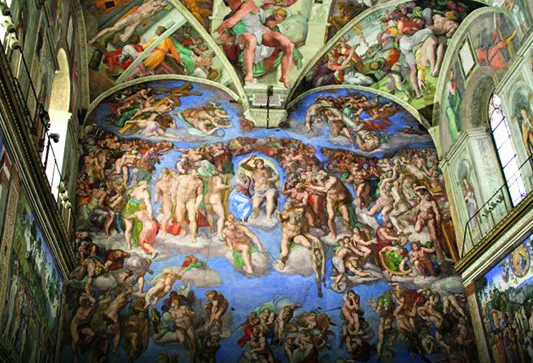
The Sistine Chapel (above): In his first example, Clark observes that interpreting Michelangelo’s massive collection of images has proven notoriously difficult for all scholars. However, he feels confident that the ceiling “passionately asserts the unity of man’s body, mind, and spirit.” Of these he feels the emphasis is clearly on the spirit. For example, he believes the key scene (below) concerning the creation of man communicates the idea of God imparting the dynamism of a human soul – like a spark – into an otherwise merely languid corporeal creature.
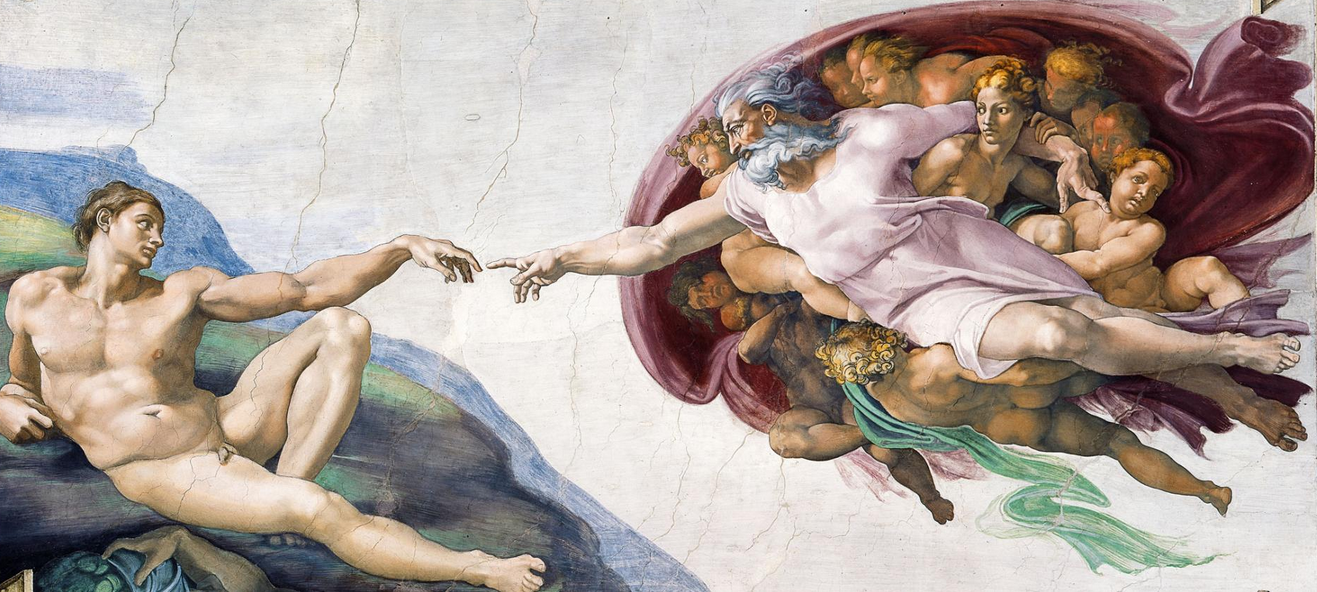
Raphael: Clark’s 2nd example of the visual depiction of the deepest thinking of the Renaissance involves Raphael
the supreme harmoniser, who absorbed and combined all that was being felt or thought by the finest spirits of his time
according to Clark
In any attempt to describe European civilisation [Raphael] must come right at the top.” In particular, “the thoughts to which he gave visible expression in the papal apartments were a synthesis as all-inclusive as the summaries of the great medieval theologians.
The School of Athens: Indeed, Raphael’s fresco, The School of Athens, is one of the most iconic pictures in history. It systematically depicts the great figures (right) at the core of the Seven Liberal Arts that constituted the field of study at the time.
Disciplines: These were divided into the Quadrivium (Arithmetic, Geometry, Music, and Astronomy) and the Trivium (Grammar, Logic, and Rhetoric). Overseeing it all on the ceiling directly above the fresco is Lady Philosophy.
Who’s Who As Clark points out, Raphael likely sought the advice of the many eminent scholars amongst the papal entourage in composing this group portrait. It is notable that the vast majority chosen are non-Christian and include, e.g., the great Muslim philosopher, Averroes; the Neoplatonist astronomer and mathematician, Hypatia; and the founder of a great dualistic religion, Zoroaster. The strong implication is not only a continuity between Classical thought and Christianity, but these with pagan thinkers also. Probable identification of the philosophers depicted is listed below. (BTW: Raphael used contemporaries as his models: e.g., Heraclitus is based on Michelangelo, Plato on Leonardo da Vinci, while Apelles is a self-portrait.)

1: Zeno; 2: Epicurus; 3: Open to speculation-; 4: Boethius; 5: Averroes; 6: Pythagoras; 7: Alcibiades; 8: Xenophon; 9: Hypatia (?); 10: Aeschines; 11: Parmenides; 12: Socrates; 13: Heraclitus; 14: Plato; 15: Aristotle; 16: Socrates; 17: Plotinus; 18: Euclid; 19: Zoroaster; 20: Ptolemy; 21: Protogenes
Plato & Aristotle: It is generally accepted that the two central figures (left) represent two 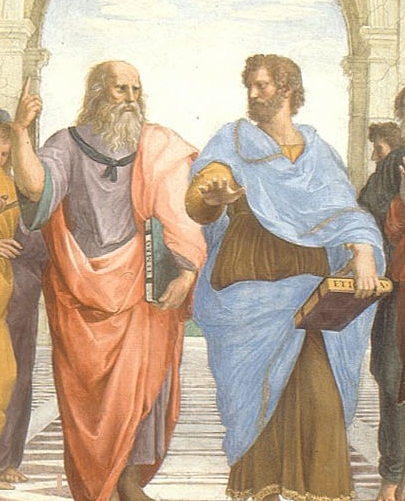 antithetical paths that can be taken in philosophy: Plato, who gestures upwards, represents idealism and the realm of the spirit; he holds his Timaeus. Aristotle, who gestures downwards, represents empiricism and the earthly realm; he holds his Nicomachean Ethics.
antithetical paths that can be taken in philosophy: Plato, who gestures upwards, represents idealism and the realm of the spirit; he holds his Timaeus. Aristotle, who gestures downwards, represents empiricism and the earthly realm; he holds his Nicomachean Ethics.
Plato had dominated Christian thought up until the 12th century, when reliable texts by Aristotle became available, leading to the development of scholasticism, led by Thomas Aquinas. This went on to dominate Catholic theology for centuries, although mystical Neoplatonism was influential during the Renaissance, as was noted in an earlier episode.
Summit of Civilisation: On the second wall, Raphael placed Disputation of the Holy Sacrament, an image of the church, spanning heaven and earth (below), and floating
in the sky above the heads of those philosophers, theologians, and Church Fathers who have tried to interpret it.
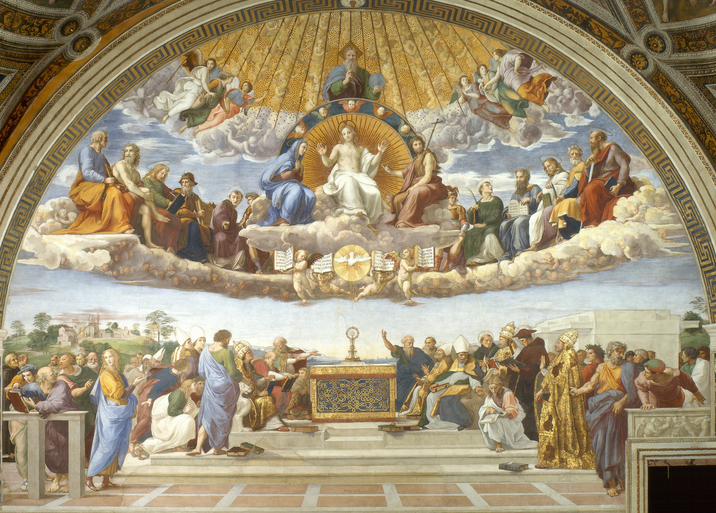
These two massive frescoes “represent a summit in civilisation.” They are complimented by a third fresco, depicting Parnassus, the dwelling place of the Apollo and the Muses (below) and the home of poetry. It is an homage to pagan abandonment, “embodying a vein of sensuous poetry as civilising as Raphael’s intellectual abstractions.” Clark discusses other important works by Raphael, including Transfiguration, and the Galatea, which fills and entire wall in the Villa Farnesina, and offers “the greatest evocation of paganism of the Renaissance.”
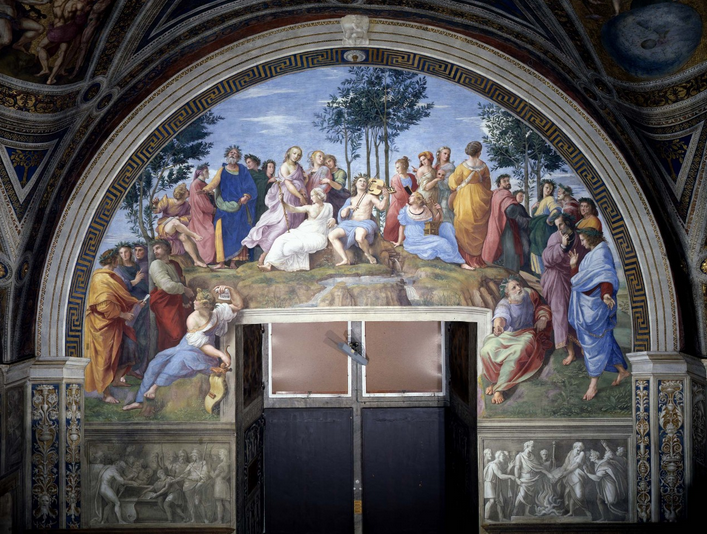
Leonardo da Vinci: Clark turns finally, in this episode, to Leonardo da Vinci, a monumental genius who fits into no era or category, and about whom, “the more you know about him, the more mysterious he becomes.” An incredible polymath, without parallel in history, Leonardo’s areas of interest included painting, sculpting, architecture, anatomy, engineering, geology, botany, optics, hydrodynamics, and mathematics. He was also an inveterate inventor, credited with predicting the parachute, the helicopter and the tank. Characteristically, he published little of his findings and they had no direct influence on later science.
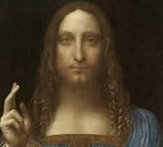 (Market Value: It was primarily his paintings that brought Leonardo fame, and of these less than 20 examples remain. One of these, Salvator Mundi (1500) a painting of Christ as ‘Saviour of the World’ (left) was sold at auction in New York to Prince Badr bin Abdullah bin Mohammed Al Farhan in November 2017, for A$590 million. It will now be on display in Abu Dhabi. This was a new record for the most expensive painting ever sold. One can only speculate how much that suggests the Mona Lisa is worth.)
(Market Value: It was primarily his paintings that brought Leonardo fame, and of these less than 20 examples remain. One of these, Salvator Mundi (1500) a painting of Christ as ‘Saviour of the World’ (left) was sold at auction in New York to Prince Badr bin Abdullah bin Mohammed Al Farhan in November 2017, for A$590 million. It will now be on display in Abu Dhabi. This was a new record for the most expensive painting ever sold. One can only speculate how much that suggests the Mona Lisa is worth.)
Unquenchable Curiosity: Clark believes Leonardo was characterized above all by his curiosity harnessed to his immense intellectual energy
he was the most relentlessly curious man in history. Everything he saw made him ask why and how. He can’t leave anything alone – he worries it; re-states it, answers imaginary antagonists.
He had one unerring orientation to the world: ask questions, seek answers, find out, write it down, draw it, paint it, build it, repeat …
Man as Mechanism: Of all the areas Leonardo explored, the focus was on human beings and how they worked, how they functioned: How does the heart pump blood? What happens when we yawn or sneeze? Why do we age?
Every question demanded dissection and every dissection was drawn with marvellous precision.
From Humanism to Pessimism: Clark believes that these endless inquiries led Leonardo to an odd conclusion in the Age of Humanism:
What does he find? That man is not at all like an immortal god. He is cruel and superstitious and feeble compared to the inexplicable, ungovernable forces of nature.
Clark draws attention to a series of drawings produced by Leonardo, in which endlessly swirling forces collide with each other in a riot of chaos. Clark believes these prophesy the world being overwhelmed by a catastrophic flood. Moreover,
the way in which Leonardo depicts this disaster shows a strange mixture of relish and defiance.
On one hand, he is recording scientific observations about hydrodynamics; on the other, he is invoking destruction of a massive scale.
The Passing of the Renaissance: All of this, Clark concludes, signals the passing of the Renaissance spirit. As we have seen, during the 15th century,
to the humanist virtues of intelligence was added the quality of heroic will.
Consequently,
for a few years it seemed that there was nothing that the human mind could not master and harmonise.
It was a golden moment and “while it lasted man achieved a stature that he has hardly ever achieved before or since.” But now, as we move into the 16th century, “the golden moment is almost over.” The Renaissance and all that it aspired to, fades away. In the next episode, Clark takes us into an age shaped around far darker views of human nature and potential.
APPENDIX: THE RENAISSANCE CHURCH
Corruption: Whatever the great artistic achievements that occurred under its auspices, the Catholic Church was lurching from crisis to crisis. Led by various Popes, it had become deeply involved in the political life of Europe, with frequent political intrigues and scandals. Its great power and wealth was accompanied by a widespread belief that it was spiritually bankrupt, a perception vastly strengthened by the Great Papal Schism of 1378 to 1417 when three Popes competed for recognition as the sole legitimate leader of the Church. As a leading Catholic historian observes: “Papal authority could not easily recover from those disastrous forty years when Christians witnessed three men wearing the papal tiara anathematizing each other. But it was not only the papacy that was in trouble; the condition of the Christian Church as a whole gave cause for alarm. At every level of Church life there were signs of grave disorganization and decay.” (Thomas Bokenkotter, History of the Catholic Church, 1979, p.207)
Abuses: Overall, on the eve of the Reformation a range of abuses were destroying the legitimacy of the Church. These included the following:
- # Monopoly of the Nobility The nobility had long secured a monopoly over the high offices of the Church:
It was quite common for a prince to have his younger sons appointed to bishoprics as the only way of securing a style of living appropriate to their station … These men were often pre-occupied with pleasure and material interests, and when the Reformation broke out they were unable or unwilling to provide spiritual leadership.”(Bokenkotter, p.209)
# Nepotism The appointment of relatives to desirable offices was widespread. It was often practiced by the popes (e.g., the Borgias). Indeed, nepotism became so extreme that Machiavelli felt obliged to attack Sixtus IV – who had elevated six of his relatives to the Sacred College – for nepotism.
# Simony The sale of ecclesiastical appointments was a principle source of papal revenue with some 2000 lucrative positions up for sale by the Pope. It was also a cause for scandal and outrage as local communities were exploited or even looted to compensate their local bishop or archbishop for the money he had to spend buying his office. For example, Albrecht of Brandenburg paid Leo X a huge sum for the position of Archbishop of Mainz. He then tried to recoup this expense by the sale of indulgences, triggering Martin Luther’s protest that led to the Protestant Revolution.
# Pluralism To compound the scandal, the papacy also accepted the practice of pluralism, whereby one ecclesiastic could hold many offices. Once again, Albrecht is a notorious example: as well as Brandenburg he was Archbishop of Magdeburg, held other lucrative bishoprics, and was a cardinal by the age of 28.
# Absenteeism To make matters even worse, many bishops never set eyes on their dioceses. In Germany as few as 7% of pastors were actually resident, farming out their duties to casual staff. (Bokenkotter, p.209).
# Clerical Decline The state of the lower clergy was also appalling:
As with the Curia and the higher clergy, we find every grade of decay: neglect of pastoral residence, accumulation of benefices, and utter worldliness. Besides, a whole clerical proletariat existed, the so-called Mass priests, who constituted in many cities as much as 10% of the population; their only function was to say daily mass. Preaching seems to have been on a very low level. Little attempt was made to instruct the young, and often the clergy themselves were as ignorant and superstitious as the rest. Concubinage was commonplace. The clergy’s training was poor; only a small percentage had any university experience. (ibid.)
# Monastic & Mendicant Decay The disasters of the Hundred Years’ War and the Black Death had undermined the monastic ideal and left many orders in disarray:
The Benedictines were mere feudal relics, having lost all touch with the new social and cultural conditions, [and] in most monasteries community life had become only a memory.” Meanwhile: “The mendicant orders too were in a sad state [and] many people regarded the sons of St Francis and St Dominic as a pack of indolent ignoramuses”
It was a view shared by Ignatius Loyola and Thomas More, as well as most of the new Humanist intelligentsia. ( p.210)
The Renaissance Popes The Reformers blamed the crisis of the Church on the papacy and its bureaucracy – the curia – insisting that the body rotted from the head down. Indeed, it is impossible to understand the Reformation without understanding the scandalous quality of the so-called ‘Renaissance Popes’, a series of popes who were concerned not with the spiritual health of the Church, but only with their self-aggrandizement, exploiting the papacy for personal, family, and dynastic gain, the pursuit of pleasure, and political intrigue:
Morally and spiritually it was a time of terrible decline. In fact, under such popes as Sixtus IV (d.1484), Innocent VIII (d.1492), and Alexander VI (d.1503), the papacy wallowed in corruption unparalleled since the tenth century.
The situation only got worse under two popes that followed: Julius II (d.1513) successfully pursued ‘great power politics’ to make the papacy a political force in Europe, but largely ruined the spiritual authority of the Church – leaving Leo X (d.1521) to finish the job.
A Case Study: the Borgias: It is impossible to do justice to the scandalous activity of all these popes, so a case study of the Borgias, a family cloaked in iniquity, will have to do.
Callixtus III: the Beginning: The iron grip that the Borgias had over the papacy and Italian politics began with the founder of the family’s fortunes, Alfons de Borja, a Spanish jurist and diplomat who reigned as Pope Callixtus III (1455-8) and kept control in Rome with the aid of Spanish troops. He had three passions: contempt for the arts and literature of the Renaissance, a desire to reclaim Constantinople from the Ottomans, and an absolute determination to entrench his family in wealth and power.
Alexander VI: the Scandal:To achieve this third aim, Callixtus granted his nephew, Rodrigo, a string of benefices, including bishoprics and abbeys, and made him a cardinal and vice-chancellor of the Holy See when he was only in his twenties, allowing him to amass a vast fortune. Rodrigo duly became Pope Alexander VI (1492-1503) after blatantly buying the votes needed. He lived an openly licentious life, fathering several children, whom he then set out to enrich in whatever ways possible, conferring numerous benefices on his sons and arranging advantageous marriages for his daughter.
His behavior was so outrageous that the very well informed Venetian ambassador was driven to conclude that Alexander had “given his soul and body to the great demon in Hell”, while his own papal master of ceremonies concluded:
There is no longer any crime or shameful act that does not take place in public in Rome and in the home of the Pontiff. Who could fail to be horrified by the…terrible, monstrous acts of lechery that are committed openly in his home, with no respect for God or man? Rapes and acts of incest are countless [and] great throngs of courtesans frequent St. Peter’s Palace, pimps, brothels, and whorehouses are to be found everywhere!
Alexander & Savonarola: It was Alexander who became the well-deserving target of the attacks of the firebrand Franciscan friar, Girolamo Savonarola, who led Florence into a puritanical rebellion.
Lucrezia & Cesare: the Offspring Bad as of Alexander’s reputation was, that of his children was horrendous. They seem to have been utterly depraved. Lucrezia allegedly committed incest with her father and brothers, and was perceived as a whore, a poisoner, a murderer, and even a witch. Cesare was widely believed to have killed his older brother in a fit of jealousy over his sister, committed systematic political assassination, amongst many other murders and crimes, and conducted a campaign of conquest and slaughter aimed at carving a Borgia kingdom based on seizing the Papal States and surrounding states. Cesare and Alexander were poisoned at a dinner when they mistakenly took the toxin meant for their guest.
The Banquet of Chestnuts: Cesare reportedly organized the infamous ‘Banquet of Chestnuts’ in the Papal Palace in1501, involving 50 ‘courtesans’, who were required to crawl around naked on the floor amid many lit candelabras picking up chestnuts, before then engaging in various sexual acts with the guests, which included Alexander, Cesare and Lucrezia.
Survival: It was in this sort of world that the Renaissance artists, architects, poets and writers had to operate.
 Sign In
Sign In 0 Items (
0 Items ( Search
Search









When Lord Clark declares of Michelangelo’s ‘David’ “one sees there has been a turning point in the human spirit” and “we become aware of a spiritual force the ancient world never knew”, my thoughts turned to Tennyson’s ‘Ulysses’ and what licence, if any, the poet took by imputing to Homer’s creation the very essence of Clark’s “spiritual force”. The Odyssey is self-evidently a tale of loyalty and perseverence, but having fought his way home to Ithaca after 20 years, Ulysses dies at the hands of Telegonus after a tiff over cattle. So much for the hero who had “drunk delight of battle far on the windy plains of Troy”. Had the old man settled into retirement, only to die defining ‘bathos’ for the world? Or did Tennyson in 1832 recognise in Homer’s tale “a spiritual force that the ancient world” knew very well?
Apart from personal collections of books, recorded music, and museum reproductions, I suppose the average Australian is connected with the civilisation described by Clark primarily through public institutions such as art galleries. My question then is, what would Clark say when confronted by the Asian or Aboriginal collections in the National Gallery of Australia?
Would he launch into a celebration of the human spirit as expressed in a form of civilisation increasingly global? Would he perhaps see some common “spiritual force” in an Aboriginal dot painting and one of my NGA favourites, Alfred Sisley’s ‘Sentier aux Sablons’? Or would he be more inclined to keep his version of civilisation within the boundaries of his original vision?
These questions do become quite pressing in this age of multiculturalism and globalism. And they might make us wonder whether in fact Clark’s civilisation is as unified as we might imagine. How much of what we value today in (for example) the great tradition of Christian art, especially the Protestant stream exemplified by Rembrandt, can be found in the works of the pagan classics in art and literature? And how much of the great artworks reflecting a modern Enlightenment or even socialist worldview can we really find in the high culture of Renaissance?
Surely the modern motto ‘Art for art’s sake’, which perhaps Kenneth Clark subscribes to – implying that great art is self-verifying without reference to any external value system – is at least doubtful? If one accepted it then one could indeed see a continuous stream of civilisation in Europe. But suppose one reads ‘Ode on a Grecian Urn’, reaching back with the author in imagination to an ideal bucolic world. On reaching the last few lines one is suddenly assaulted with the frankly ideological message “Beauty is truth, truth beauty”. Keats is celebrating the Romantic myth of the noble ancient pagan (brother to the noble savage). His ‘Ode’ is persuasively self-verifying. But is it also propaganda for another vision of civilisation, before Christianity came along, that puts man back into a state of nature and leaves him there?
It seems to me we need to beware of being overawed by the use of consummate artistic skill to convey messages that may not be spiritually wholesome. I would not be puritanical or censorious or (hopefully) unappreciative of works that exhibit the heights of human achievement in the arts. But discrimination ought to be encouraged and spiritual discernment employed to moderate one’s responses. There is no law that says one has to admire this or that great work for any reason other than its technical and aesthetic achievement. But if in art one finds a spiritual home, one should choose wisely.